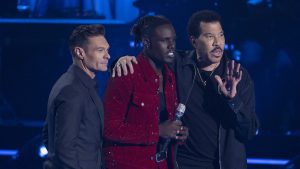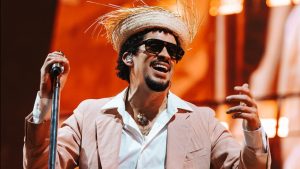
Jason Momoa Describes the “Ultimate Horror” in That Horrific ‘Chief of War’ Episode
Logo text
[This story contains spoilers up to episode seven of Chief of War, “Day of Spilled Brains.”]
Jason Momoa has waited his entire life to make Chief of War, the ambitious new Apple TV+ series that dramatizes the reunification of Hawai’i in the late 18th and early 19th centuries. After making a career largely out of playing fictional action heroes — Aquaman in the DC Universe, an ill-fated nomadic warlord in Game of Thrones, a swordmaster in the Dune movies — the 46-year-old finally gets to play a real-life superhero in a passion project set in his father’s homeland.
Co-created by Momoa and Thomas Pa’a Sibbett, the nine-part series — which could be renewed for more seasons — stars Momoa as Native Hawaiian warrior Ka’iana. Over the course of the first season, Ka’iana returns home from traveling overseas — where he witnessed the horrors of slavery, famine and monetary greed — with the goal of unifying the four warring kingdoms of the Hawaiian Islands to save his own people from the threat of colonization. However, he is ebuffed at every turn by his fellow chiefs, most notably Kamehameha I (Kaina Makua), who later becomes the conqueror and first ruler of the Kingdom of Hawai’i.
The series features a cast of predominantly Polynesian actors speaking in multiple languages and was filmed in Hawai’i and New Zealand as an unprecedented retelling of Hawaiian history from a distinctively native perspective.
“Everyone that has come here has these vacations and brings home these memories, but they fall in love with Hawaii. Now, they’re going to be in the comfort of their home watching the history — stuff that they didn’t even know about,” Momoa tells The Hollywood Reporter on a recent video call from Hawai’i. “But what it’s going to do for us, for Indigenous [actors], and how it resonates with our people — that’s all I care about. We are the great, great grandchildren bringing all of this back and trying to inspire the next generation.”
At a time when history is being erased in classrooms across the country, Momoa adds, “I don’t think anyone knows a part of this American history, so I think there’s a lot of things that people are going to be like, ‘Holy shit!’ And they’re going to get a big deep dive into what went on here. I think they’re going to be really interested.”
Below, executive producers and longtime collaborators Momoa and Sibbett open up about why they decided to use Ka’iana as the entry point in this retelling of Hawaiian history, how they thought about the interplay between the English and ʻŌlelo Hawai’i languages, and how the end of the seventh episode — titled after the real-life “Day of Spilled Brains,” a tragic moment in Hawaiian history — sets the tone for the life-and-death stakes of the final two episodes.
***
You two were first approached to tell the story of Kamehameha I about a decade ago, but you chose to include that historical figure in a larger series centered around Ka’iana. What do you remember from your initial conversations with each other about this project, and how did that idea evolve into the final product we see in Chief of War?
JASON MOMOA We actually had a different script.
THOMAS PA’A SIBBETT Tthe truth is that Kamehameha’s story would be a slam dunk for Hollywood. It’s got all the [elements] you need and would want. So we did talk about it. It was something we thought about, and ultimately it just wasn’t our place to tell it. There was a lot involved with that, culturally speaking.
MOMOA Also, I would never play Kamehameha. I would never have the balls, to say the least, to actually think I could play someone with that stature. So we wanted to find a story that could encompass the whole world, because there were many people like Kahekili or Kamāmalu. So Thomas did come up with an idea for the story of Ka’iana. He was actually the most famous Hawaiian at that time, because he had set sail around the world and went to so many different places that he was very well-known.
So that became very interesting, as a journeyman myself, to go, “Wow, what an interesting story to come from this world, to be a reluctant war chieftain who felt like he was done wrong and then actually betrayed again, and then he flees where he’s from — only to see slavery, sickness and just everything as he went around the world.” [He was able] to go up to Alaska and then bring back 10 war canoes filled with weapons to then help unify the islands because [he thinks they] need to get everything together because of what’s coming [to their shores].
To have that kind of perspective is a disease, in a way. He can never go back [to his old way of thinking] because of what he has seen, and then he can’t really connect to anyone in his culture, but he also wants to help them and save them because he knows what’s coming and [the importance of] being able to trade with the rest of the world. So I feel like that story is very complex. I’ve never quite played a character like that, and I don’t necessarily agree with a lot of the views that he has.
A lot of these characters — the things they have done — it’s pretty crazy to connect [the events]. We have [to go from point] A to B, but there’s so much we had to fill in that we don’t know. So it’s been an amazing partnership and the time to create worlds like this is exciting. If people love this, this show opens up — it gets even bigger. And that’s exciting, once you go down the rabbit hole of the history. We’re hitting historical moments, but also, we’re condensing time in some ways.
SIBBETT It is wonderful to be able to attack a story this way, and realistically, it’s what happens when stories can be built from the inside out. That was the other approach we had. We realized that, yes, Kamehameha is a story that would work and people would enjoy that. But if you ask us, we know our history [so well] that it’s like, “Well, look, if you shift the perspective just a little bit, you hit this guy instead of that guy.” Now we have a whole other world that audiences would’ve never known about.
Ka’iana is such a lesser well-known story. Despite his positioning in that time period, he was truly the only Hawaiian that people ever talked about. They were coming to the islands looking for him. They had heard about him or worked with him. Captains were like, “Now we know these islands exist. So where is he? Can he guide us? He can help us.” What a great fertile ground for storytelling, and the story that I don’t think anybody else would’ve found if they didn’t have that insider connection to Hawai’i itself.
Jason Momoa as Ka’iana in Chief of War.
Apple TV+
Jason, to your point, Ka’iana was the first chief to travel around the world, and he returned with a very clear understanding of the threat that colonization would pose to his people, even though the four islands were warring at the time. How did you think about creating an emotional arc for him over the course of these nine episodes? How did you want him to evolve as a leader?
SIBBETT We’re trying to be careful, because to talk about Ka’iana is to talk about his whole journey, which is a story that we still want to tell. So if we’re just keeping it within the context [of this season], it really is everything that Jason described. He’s a guy who ends up in a foreign land and his eyes are being opened. It would be the equivalent of landing on the moon and seeing aliens and how they operate, and then having to go back home and warn people the aliens are coming. It’s great for character, and that’s really what we can explore this season. Him seeing the danger, trying to ring the alarm — and how do you do that to people who have never seen the moon?
MOMOA Ka’iana is struggling because he wants to] revolt against his king, to go against Kamehameha, knowing that these guys are bad, that this white man is bad, that he’s twisted these things. And then [he has] to go, “No, this is māmalahoe. We don’t do this. These are our rules and our laws. But you know that he’s going to hurt people, and you have to go against your king” — and that’s just the human condition going, “Fuck, they’re wrong and you’re wrong. This needs to stop.” You’re in the same position going, “Oh man, we know this is what’s going to happen [to these Hawaiians],” so you’re torn as an audience member.
SIBBETT But that urgency causes them to make mistakes. What’s great about the story is that just because you know something doesn’t mean you’re making the right decisions. We are following this character, we’re trusting him — and then all of a sudden he messes up, or he’s in a situation where he is 100 percent correct, and they better listen to him. This story is as universal as anything else, and we were excited to dig into it and allow the story to be told to introduce us to this world, but really follow all of these great characters that lead us to a really great story.
I’m very fascinated by the way you balance ʻŌlelo Hawai’i with English in this show. The first two episodes are entirely in the native Hawaiian language, and the arrival of some non-Hawaiian characters — mostly white stowaways and a Black slave — gradually introduces English into the mix. At some point later in the season, some Hawaiian characters only want to speak in their native language, some only want to speak in English, and some switch seamlessly between the two languages depending on the situation or the person they’re interacting with. How did you think about the interplay and interaction of language in this show?
SIBBETT When you take a step back and look at the big picture, language is also a representation of what we give and take when cultures are mixed and start to come together. There’s some good things, there’s some bad things. Communication’s obviously key. Hawaiians actually had an edict from a king that said, “I want you all to learn to read and write English.” Within 50 years, Hawai’i’s 97 percent, almost 98 percent completely literate — the highest literacy rate of any country around the world. So it’s understanding that Hawaiians were adaptive, that they actually valued learning, and we get to show that through this course of language.
MOMOA I sometimes get extremely pissed off when you watch a movie, and you’re like, “Why am I watching this guy do it in a Native American accent? It’s a French movie.” There’s always those choices that you have to make, but there’s just no way you would ever make this without it being in the Hawaiian language — and it’s the most beautiful language in the world. Having said that, my character obviously travels outside of there. If you were going to be a war chief, the first thing you’re going to know is your enemy. You’re going to know your surroundings, you’re going to learn the [enemy’s] language. You would be an idiot, a horrible chief of war, if you did not understand the other language of everyone. So it is very essential for me to learn.
We condensed time, but he went on many journeys and then came back. Obviously, we wanted everyone else to be learning too, because Kamehameha had advisors, they had stowaway white guys who were teaching the language to them, and we wanted them to be educated and get through it quickly. But certain people like Keōua, Kahekili, Kamehameha — [the English language] makes no sense to them. They can have their advisors be [focused on] all that [English]. So it was a nice blend.
Moses Goods in “Day of Spilled Brains.”
Apple TV+
Each episode feels epic and cinematic in scope and scale, but one of the most gut-wrenching moments happens at the end of episode seven, when Captain Simon Metcalfe (Jason Hood) and his crew, after their offer of trade was kindly but firmly rejected by Chief Kamehameha, go to the nearest bay, fill their canons with nail bombs, and opens fire on hundreds of innocent Hawaiians. Jason, can you give voice to what is going through Ka’iana’s mind as he watches his worst nightmare — the senseless killing of his own people at the hands of the “paleskins” — come true from afar?
MOMOA That was the ultimate horror. It’s to come back, know what’s coming, and then voice what you’ve seen, and not be trusted and then also have to live by some laws that you necessarily don’t believe in anymore. [Ka’iana now believes] there aren’t these gods, they aren’t going to look after us, and these people are going to hurt us if we don’t get aligned. So to be muzzled and not be heard, but also be poisoned by the outside rule, I feel like he’s coming back [to Hawai’i] and carrying that [burden]. He feels inflicted when he comes back, but he can’t let that go.
The king says, “You are not allowed to do this. You can’t retaliate.” But then when [the massacre] happens, all these people were murdered for nothing because they didn’t listen. You’re in these places where they’ve never been this way before. These are the first times this [kind of outside violence] has ever happened to these people — and it’s frustrating for the audience, it’s frustrating for the characters even when we’re both wrong in many ways.
Ka’iana constantly keeps trying to do stuff, and the door keeps shutting. When you look at all the advisors, some of the main advisors are stowaways. These paleskins were probably the lowest of lows [in the social hierarchy in England], but they just happened to survive, and they’re the advisors to Kamehameha because they’ve seen the world. So imagine that: Someone who isn’t necessarily a high-ranking [official], but because they’re there and can advise and whisper in the ear of our king, they can spread rumors about everyone, really.
SIBBETT One thing to point out, because you’re talking about something really specific, is that this whole section is actually historically accurate. There was that confrontation on the ship beforehand where Ka’iana just believed that they couldn’t allow Captain Metcalfe to continue to operate in Hawai’i. Kamehameha turned it down and said, “No, man, I don’t know why you would want to kill him.” And he didn’t quite understand that. So Ka’iana did try to sneak on board with his men, and they did try to take out Captain Metcalfe, but he was stopped by Kamehameha. They argued in Hawaiian, and the crew didn’t quite understand what was going on. So for Jason, as an actor, he had to then fill in the gaps to figure out, “Well, now what kind of emotion does that evoke?” Because history wrote that story for us.
The massacre that happened [in this episode] really did take place. It’s a real thing that happened at Olowalu. It has to be something that the character goes through because we are still dealing with the trauma of that event today. When Simon Metcalfe left [Hawai’i in real life], he didn’t technically go into the next harbor; he went to the next island. But for us, it was a way for us to be able to say, “Look, this is a real story. The only difference in the writing was to make sure that Ka’iana’s character gets to experience it.” Our characters are all impacted by it, because the truth is we’re still affected by it today. The name of the episode is “Day of Spilled Brains,” because in Hawaiian we refer to that event as Kalolopahu, or “Day of Spilled Brains.”
How did you figure out the logistics of shooting that massacre scene? Did you ever consider having that attack play out in a different way?
SIBBETT It was tricky, because Hawaiians actually went out to sea to meet him [in real life], and the first version of the story was Hawaiian canoes were getting shot and people were getting hit and being dragged out of the water. It’s a lot. So to make it easier, we decided to do it where the ship is there [on the water], and they shoot onto land. Of course, that in and of itself is still impactful and traumatizing, but it’s not near as bad as it really was. But if you want to talk real logistics, that particular scene was actually shot in Aotearoa [New Zealand], and we needed to make sure that we were okay with the tribes to shoot on their land and to tell the story of this type of significance. [We asked] whether or not we should even put explosives underneath the sand — is that going to cause issues to their local marine life and all of that? So there was a lot taken into account for that scene — from the writing to the location to making sure that we were also culturally appropriate to the tribes in that area.
Jason Momoa and Luciane Buchanan in “Day of Spilled Brains.”
Apple TV+
Circling back to the start of this conversation, there are decades of history you could retell in this show, but you had to figure out what to include and not include in just nine episodes — with the hope of potentially returning to tell more of that story in subsequent seasons. How did you settle on the “Day of Spilled Brains” as a launching-pad into the final episodes of season one? Did you always know you wanted to include this horrific moment in history?
SIBBETT I think we were always planning on doing it. It is the wounded knee of Hawai’i. It’s important because it enables us to really look at this point in history and dissect what went wrong. Not everything about cultures coming together is bad, but this was one of them. History gives us the ability to look back and see what led to it, what caused it, what was the mindset, and for us to make sure we’re not making these types of mistakes again. Story-wise, it was just a matter of figuring out how we’re going to make it fit, and what parts of it needed to be dramatized in order for it to work. But a lot of the history was there.
I always thought it was fascinating from that point of view to say, “So if Ka’iana had killed Captain Simon Metcalfe, then that massacre would’ve never happened.” But on the flip side, you could argue, “Well, was [Ka’iana] one of the reasons why [Metcalfe] did it?” So it becomes this really interesting moment in history where everybody could take blame for it. Simon Metcalfe clearly takes blame for it, but everybody, depending on how you’re looking at the story, can take some blame.
***
Chief of War is now streaming on Apple TV+, with the season finale set to drop on Sept. 19.










